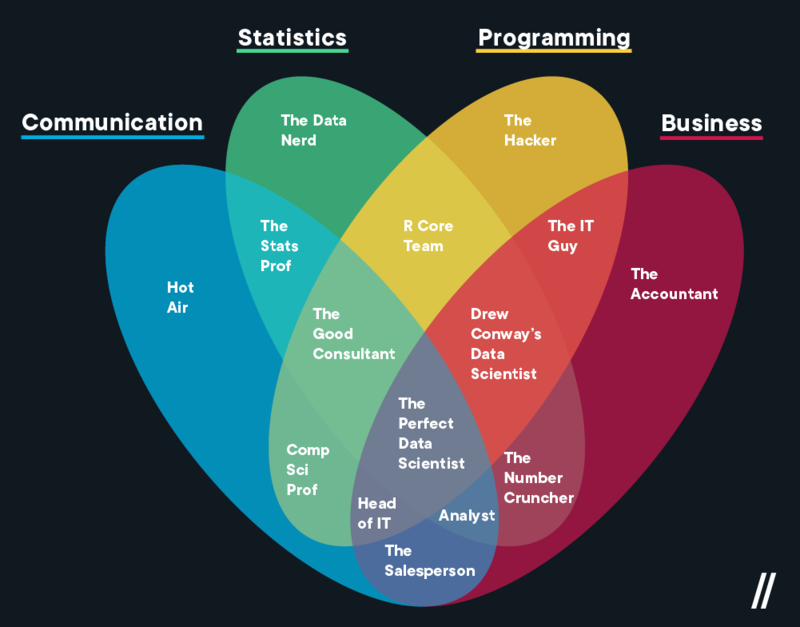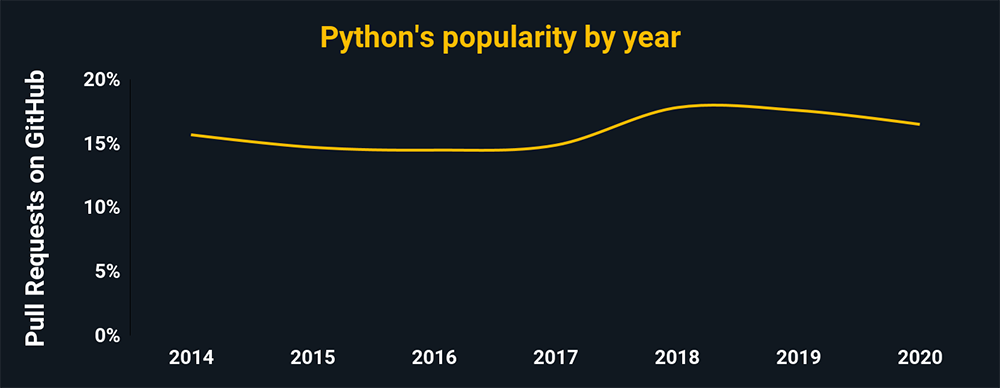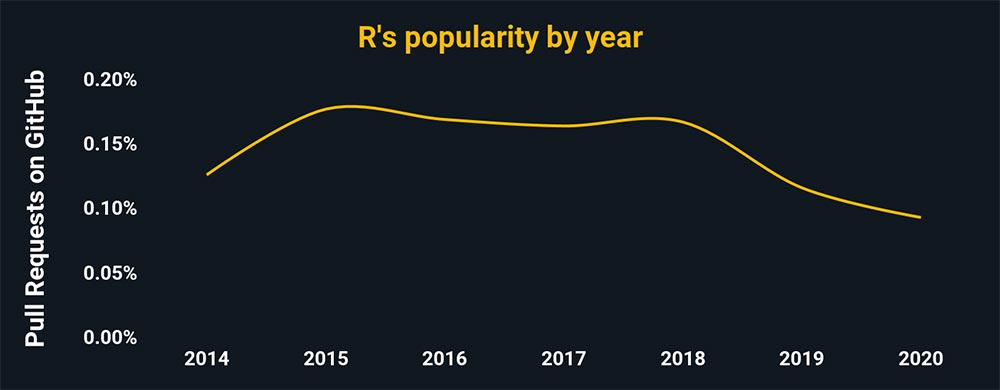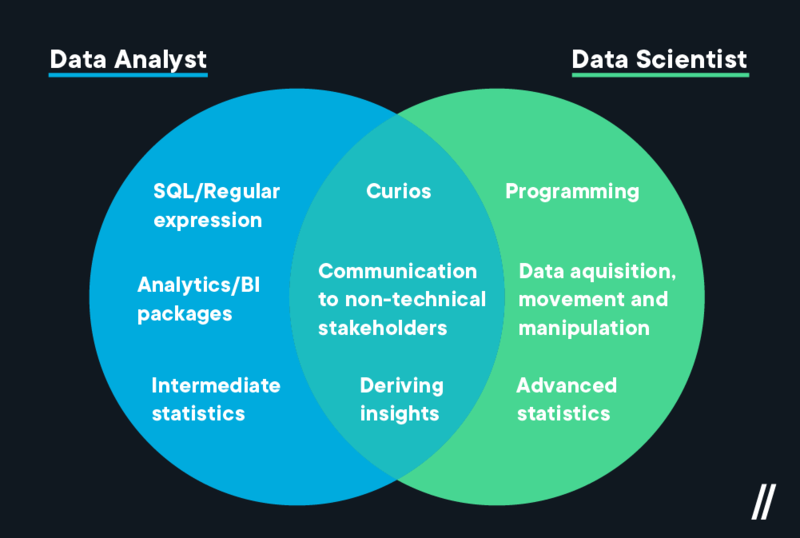Data science draws elements from computer science, modeling, mathematics, statistics, and analytics. Data scientists use these elements to analyze and interpret vast reserves of data to extract actionable insights. Business managers can then use these insights to drive business decisions.
To interpret big data, data scientists have to:
- Clean and massage the data extensively, discarding irrelevant information and preparing it for preprocessing and modeling
- Build statistical models that expose key patterns in large datasets
- Communicate predictions and findings to stakeholders
For organizations trying to solve complex problems, data scientists hold the key to making objective, data-driven decisions.
Netflix, for example, has a recommendation system that tracks the programs a viewer has watched to predict what they might like to watch next. This is done by comparing the viewer’s watch history with “taste groups”— sets of users that watch similar content — and recommending programs that commonly occur within those closely matched with theirs. These taste groups are identified through machine learning and algorithms — and likely involved teams of data scientists to build.

Data scientist roles and responsibilities
Data scientists are responsible for carrying out a number of tasks in their day-to-day work, including:
- Working with non-technical stakeholders to understand business goals
- Brainstorming ways to use data to accomplish those goals
- Collecting vast amounts of data from disparate sources
- Data mining
- Database management
- Cleaning and massaging the data to ensure accuracy and consistency
- Conducting exploratory data analyses
- Designing and deploying algorithms and predictive models to mine the data, find patterns, and extract actionable insights
- Understanding, evaluating, and improving results
- Conveying predictions and insights to non-technical peers and stakeholders
- Adjusting models based on feedback from stakeholders
As you can probably tell, a data scientist’s responsibilities rely on having both a strong technical background and communication skills that enable them to clearly present their analysis.
What skills are needed to be a data scientist?
A data scientist’s skillset typically spans multiple categories, including statistical analysis, machine learning, mathematics, programming, and data storytelling. Data scientists also need various soft skills to help them think critically about business needs and communicate their findings to non-technical stakeholders.
Let’s take a closer look at each of these categories and see exactly which skills aspiring data scientists need to add to their toolkit.
Strong math skills
Strong math skills are necessary in data science. The three areas of math most commonly cited as essential are calculus, linear algebra, and statistics. However, for most data science positions, statistics is the only branch of math you really need to master.
Programming languages
Data scientists need to write code to clean, analyze, and build models based on large datasets. Commonly used programming languages in data science include Python, R, and SQL. Other key technologies include open-source software library Apache Hadoop as well as analytics engine Apache Spark.

Python
Python is an object-oriented programming language that is easy to use and developer-friendly. Its key features include high code readability and a strong developer community. It’s perfectly suited for tasks like data collection, analysis, modeling, and visualization.

R
R is an open-source programming language and software environment used primarily to address statistical and graphical tasks like clustering, linear and non-linear modeling, time series analysis, and plotting. It tends to be used more in academic contexts than in industry.
SQL
SQL is the standard language for connecting to and communicating with relational databases. It also simplifies common data science tasks like data preprocessing by allowing programmers to identify specific subsets of data and filter, sort, and summarize them based on predefined criteria.
Hadoop
Apache Hadoop is a highly scalable open-source software framework that allows for the storage and parallel processing of extremely large datasets in a distributed computing environment. Data scientists often use Hadoop as a file store in conjunction with an RDBMS system.
Spark
Apache Spark is an in-memory data analytics engine known for its scalability, lightning-fast processing speeds, and sophisticated analytics capabilities. Spark supports map and reduce functions, SQL queries, and data streaming as well as more advanced ML and graph algorithms.
While you don’t need to be an expert on all of the above to begin with, being able to code and having some familiarity with these technologies is typically expected.
Machine learning
Machine learning is the study of computer algorithms that improve automatically using massive amounts of data. These algorithms use statistics to find patterns in extremely large datasets. Data scientists can use machine learning techniques to make predictions based on data.
Data storytelling
Much of a data scientist’s work involves communicating their findings to a non-technical audience. To do this, data scientists must extract actionable insights applicable to the business problem they’re helping to solve.
Soft skills
Data scientists also need to hone soft skills like business intuition, critical thinking, analytical thinking, and interpersonal skills.
Is data science a good career?
Data science is a field with plenty of opportunities for growth. Data science has experienced a 650% increase in job growth since 2012, and the U.S. Bureau of Labor Statistics predicts an estimated 11.5 million new jobs in data science by 2026.
Common data scientist job titles
Careers in data science span a variety of roles, including:
Data scientist
Data scientists design data processes and algorithms to build predictive models that help drive objective decision-making.
Data analyst
Data analysts examine, manipulate, and analyze large data sets to support business decisions. The process is typically less technical than in data science. They might also track web analytics, conduct A/B testing, and prepare reports for management.

Data engineer
Data engineers are responsible for real-time or batch processing of stored data. This processing includes cleaning, aggregating and organizing data from disparate sources and transferring it to data warehouses. Data engineers also build data pipelines to make data easy to access for data scientists.
Business intelligence (BI) developer
BI developers use tools or develop custom applications to help business users find and understand the information they need to make objective, data-driven business decisions.
How much money do data scientists make?
Robert Half Technology’s 2020 Salary Guide shows that data scientists earn an average annual salary of between $105,750 and $180,250 per year. Compensation can, however, vary significantly depending on location and job function.
Compensation also depends on seniority. Here are some salary estimates for more senior data science roles:
What’s the difference between a data scientist and a data analyst?
The role of the data scientist is commonly confused with that of the data analyst. Data scientists are primarily responsible for developing data modeling processes and algorithms to build predictive models. Their work is more technical and higher in seniority compared to that of a data analyst.
In contrast, data analysts collect, organize, and examine data to identify key insights and draw conclusions. They might use statistical or business intelligence tools (e.g. Microstrategy) to help them interpret the data and prepare reports for stakeholders.
Starting a career in data science
Data science skills are usually built on foundations heavy in math and computer science. If you don’t already possess the necessary technical background for an entry-level data science role, there are three different paths you can consider:
- Self-teaching
- Bootcamps
- Higher education
Ultimately, each path comes with its own pros and cons. Think about your individual learning style. Answering some core questions about your learning style will help you decide which path to take. For example, do you learn better:
- In groups or by yourself?
- In-person or remotely?
- Quickly or slowly?
- By reading or being hands-on?
Path 1: Self-teaching
Teaching yourself requires a great deal of discipline. You also need to thoroughly research and evaluate material to ensure that you’re focusing on the right skills. If you choose this route, there are plenty of books and online resources that can help you get started.
Books and resources
Introduction to Data Science from Alison
A free three-hour online course covering data science processes, introductory machine learning, and data models for structuring data.
Dataquest: Learn R, Python and SQL for Data Science
An online training platform that provides free data science learning resources such as “Python for Data Science,” “Exploratory Data Visualization,” “Data Cleaning and Analysis,” “Fundamentals of SQL,” and more.
Johns Hopkins & Coursera: Data Science Specialization
A ten-course introductory specialization in data science developed and taught by Johns Hopkins University professors through Coursera. The specialization includes classes like “R Programming,” “Exploratory Data Analysis,” “Regression Models,” and “Practical Machine Learning.”
IBM Data Science Professional Certificate
A nine-course data science program covering Python, SQL, databases, data visualization, statistical analysis, machine learning algorithms and predictive modeling. The program also gives you a chance to build a data science portfolio, as it includes projects that rely on IBM Cloud, various data science tools, and real-world data sets.
Free Intro to Data Science
Flatiron School’s introductory data science course covers Python and machine learning and consists of the beginning modules of our full-time data science course.
Data Science From Scratch: First Principles of Python by Joel Grus
An introductory book covering the basic math, statistics, and programming fundamentals needed for data science. You will receive a crash course in Python, linear algebra, statistics and probability, data cleaning, and basic machine learning models.
Pros and cons of self-teaching
Pros
- Self-teaching is free or relatively inexpensive.
- You can learn at your own pace.
- You can spend more time on subjects you’re struggling with.
- You’re free to use a variety of materials from multiple sources.
- You can learn using the medium that best suits your needs and preferences.
Cons
- It’s difficult to stay disciplined.
- Ensuring you’re learning the right skills is challenging.
- There is no career guidance after you’ve finished your studies.
- You don’t have access to educational advisors.
- Hiring managers may not consider self-teaching a valid education.
- Most self-teaching resources don’t offer the chance to build a portfolio.
Path 2: Bootcamps
You might be asking yourself, “how do I become a data scientist from scratch?” If you have no experience in data analysis, there is an option for you: data science bootcamps.
A data science bootcamp is an intensive, short-term training program dedicated to teaching the skills necessary to succeed as a data scientist. Some bootcamps, like those at Flatiron School, work with employers and hiring companies to create a curriculum that prepares students to get data science jobs.
Bootcamps are also typically more hands-on than a traditional degree program, giving you the opportunity to work on projects. That way, you’ll graduate with a full portfolio to help showcase your skills during job interviews.
Best data science bootcamps
Flatiron School’s data science bootcamp teaches you the skills you need to become a data scientist in as little as 15 weeks. The curriculum covers Python, SQL, statistics, A/B testing, linear regressions, combinatorics, probability theory, statistical distributions, Bayes Theorem, sampling methods, hypothesis testing, model evaluation, and more.
Pros and cons of bootcamps
Pros
- Bootcamps offer a hands-on approach to learning.
- You can be confident that you are focusing on the right skills and material.
- Bootcamps are more affordable than most university degrees and can be done part-time.
- Many bootcamps offer 1:1 career coaching after graduation.
- You can connect with other aspiring data scientists.
- Bootcamp instructors are aware of the latest market and employer needs.
- Hiring managers favor bootcamp graduates over self-taught data scientists.
Cons
- Bootcamps often have high upfront costs.
- Although shorter than a university degree, bootcamps can involve intense, long hours.
- FAFSA and other federal financial aid programs are typically not applicable to bootcamps.
- Bootcamp material is typically less in-depth than computer science degree programs.
- Bootcamps can be quite fast-paced.
- There are still managers who prefer computer science degrees over bootcamp programs.
Path 3: Higher education
The final option is to pursue a formal education in data science. A standard data science degree will typically be a Master of Science in Data Science, Data Analytics, Business Analytics, or a related field.
Pros and cons of getting a data science degree
Pros
- You can be confident that you are focusing on the right skills and material.
- A degree program might be less fast-paced and intensive than a bootcamp.
- Degree programs typically provide more in-depth material than bootcamps.
- Universities offer career fairs, career services, and other forms of job search assistance.
- You can apply for federal financial aid.
- Many hiring managers favor formal computer science or data science degrees over coding bootcamps.
Cons
- Degrees cost much more than a bootcamp or self-teaching.
- Degrees take much longer than a bootcamp program.
- Many degree programs require you to study full-time for two years.
- Formal academic institutions may not be fully up-to-date on the latest industry trends and market needs.
- Degree programs are often more theoretical and less hands-on.
Conclusion
Data science is a rich, fast-growing field with lots of potential for growth. And data science bootcamps are an excellent choice to help you gain the skills you need.
If you’re willing to work hard and learn the right skills, you can carve out a path to your first data science role. Get the skills you need to become a data scientist at Flatiron School. We have full-time programs and flexible pacing options to meet your learning style, lifestyle, and schedule.
Not sure if you’re ready for a bootcamp yet, but still want to try your hand in data science? Try learning Python for free.




